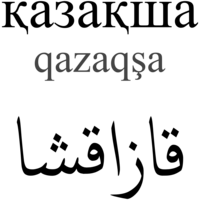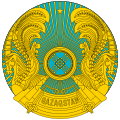|
Kazakh language
Kazakh or Qazaq[a] is a Turkic language of the Kipchak branch spoken in Central Asia by Kazakhs. It is closely related to Nogai, Kyrgyz and Karakalpak. It is the official language of Kazakhstan, and has official status in the Altai Republic of Russia. It is also a significant minority language in the Ili Kazakh Autonomous Prefecture in Xinjiang, China, and in the Bayan-Ölgii Province of western Mongolia. The language is also spoken by many ethnic Kazakhs throughout the former Soviet Union (some 472,000 in Russia according to the 2010 Russian census), Germany, and Turkey. Like other Turkic languages, Kazakh is an agglutinative language and employs vowel harmony. Kazakh builds words by adding suffixes one after another to the word stem, with each suffix expressing only one unique meaning and following a fixed sequence. Ethnologue recognizes three mutually intelligible dialect groups: Northeastern Kazakh—the most widely spoken variety, which also serves as the basis for the official language—Southern Kazakh, and Western Kazakh. The language shares a degree of mutual intelligibility with closely related Karakalpak while its Western dialects maintain limited mutual intelligibility with Altai languages. In October 2017, Kazakh president Nursultan Nazarbayev decreed that the writing system would change from using Cyrillic to Latin script by 2025. The proposed Latin alphabet has been revised several times and as of January 2021 is close to the inventory of the Turkish alphabet, though lacking the letters C and Ç and having four additional letters: Ä, Ñ, Q and Ū (though other letters such as Y have different values in the two languages). Over one million Kazakh speakers in Xinjiang use a modified version of the Perso-Arabic script for writing. It is scheduled to be phased in from 2023 to 2031.[5] Geographic distributionSpeakers of Kazakh (mainly Kazakhs) are spread over a vast territory from the Tian Shan to the western shore of the Caspian Sea. Kazakh is the official state language of Kazakhstan, with nearly 10 million speakers (based on information from the CIA World Factbook[6] on population and proportion of Kazakh speakers).[7] In China, nearly two million ethnic Kazakhs and Kazakh speakers reside in the Ili Kazakh Autonomous Prefecture of Xinjiang. HistoryThe Kipchak branch of Turkic languages, which Kazakh is borne out of, was mainly solidified during the reign of the Golden Horde. The modern Kazakh language is said to have originated in approximately 1465 AD during the formation of the Kazakh Khanate. Modern Kazakh is likely a descendant of both Chagatay Turkic as spoken by the Timurids and Kipchak Turkic as spoken in the Golden Horde. Kazakh uses a high volume of loanwords from Persian and Arabic due to the frequent historical interactions between Kazakhs and Iranian ethnic groups to the south. Additionally, Persian was a lingua franca in the Kazakh Khanate, which allowed Kazakhs to mix Persian words into their own spoken and written vernacular. Meanwhile, Arabic was used by Kazakhs in mosques and mausoleums, serving as a language exclusively for religious contexts, similar to how Latin served as a liturgical language in the Western European cultural sphere.  The Kazakhs used the Arabic script to write their language until approximately 1929. In the early 1900s, Kazakh activist Akhmet Baitursynuly reformed the Kazakh-Arabic alphabet, but his work was largely overshadowed by the Soviet presence in Central Asia. At that point, the new Soviet regime forced the Kazakhs to use a Latin script, and then a Cyrillic script in the 1940s. Today, Kazakhs use the Cyrillic and Latin scripts to write their language, although a presidential decree from 2017 ordered the transition from Cyrillic to Latin by 2031. Phonology and orthographyKazakh exhibits tongue-root vowel harmony, with some words of recent foreign origin (usually of Russian or Arabic origin) as exceptions. There is also a system of rounding harmony which resembles that of Kyrgyz, but which does not apply as strongly and is not reflected in the orthography. This system only applies to the open vowels /e/, /ɪ/, /ʏ/ and not /ɑ/, and happens in the next syllables.[8] Thus, (in Latin script) jūldyz 'star', bügın 'today', and ülken 'big' are actually pronounced as jūldūz, bügün, ülkön. ConsonantsThe following chart depicts the consonant inventory of standard Kazakh;[9] many of the sounds, however, are allophones of other sounds or appear only in recent loanwords. The 18 consonant phonemes listed by Vajda are without parentheses—since these are phonemes, their listed place and manner of articulation are very general, and will vary from what is shown. (/t͡s/ rarely appears in normal speech.) Kazakh has 19 native consonant phonemes; these are the stops /p, b, t, d, k, ɡ, q/, fricatives /s, z, ɕ, ʑ, ʁ/, nasals /m, n, ŋ/, liquids /ɾ, l/, and two glides /w, j/.[10] The sounds /f, v, χ, h, t͡s, t͡ɕ/ are found only in loanwords. /ʑ/ is heard as an alveolopalatal affricate [d͡ʑ] in the Kazakh dialects of Uzbekistan and Xinjiang, China. The sounds [q] and [ʁ] may be analyzed as allophones of /k/ and /ɡ/ in words with back vowels, but exceptions occur in loanwords.
VowelsKazakh has a system of 12 phonemic vowels, 3 of which are diphthongs. The rounding contrast and /æ/ generally only occur as phonemes in the first syllable of a word, but do occur later allophonically; see the section on harmony below for more information. Moreover, the /æ/ sound has been included artificially due to the influence of Arabic, Persian and, later, Tatar languages during the Islamic period.[12] It can be found in some native words, however. According to Vajda, the front/back quality of vowels is actually one of neutral versus retracted tongue root.[11] Phonetic values are paired with the corresponding character in Kazakh's Cyrillic and current Latin alphabets.
Vowel harmonyKazakh exhibits tongue-root vowel harmony (also called soft-hard harmony), and arguably weakened rounding harmony which is implied in the first syllable of the word. All vowels after the first rounded syllable are the subject to this harmony with the exception of /ɑ/, and in the following syllables, e.g. өмір [ø̞mʏr], қосы [qɒso]. Notably, urban Kazakh tends to violate rounding harmony, as well as pronouncing Russian borrowings against the rules.[13] StressMost words in Kazakh are stressed in the last syllable, except:[14]
OrthographyNowadays, Kazakh is mostly written in the Cyrillic script, with an Arabic-based alphabet being used by minorities in China. Since 26 October 2017, via Presidential Decree 569, Kazakhstan will adopt the Latin script by 2025.[15][16] Cyrillic script was created to better merge the Kazakh language with other languages of the USSR, hence it has some controversial letter readings. The letter У after a consonant represents a combination of sounds і /ɘ/, ү /ʉ/, ы /ə/, ұ /ʊ/ with glide /w/,[17] e.g. кіру [kɪ̞ˈrɪ̞w], су [so̙w], көру [kɵˈrʏ̞w], атысу [ɑ̝təˈsəw]. Ю undergoes the same process but with /j/ at the beginning. The letter И represents a combination of sounds: i /ɘ/ (in front-vowel contexts) or ы /ə/ (in back vowel contexts) + glide /j/,[17] e.g. тиіс [tɪ̞ˈjɪ̞s], оқиды [wo̞qəjˈdə]. In Russian loanwords, it is realized as /ʲi/ (when stressed) or /ʲɪ/ (when unstressed), e.g. изоморфизм [ɪzəmɐrˈfʲizm]. The letter Я represents either /jɑ/ or /jæ/ depending on vowel harmony. The letter Щ represents /ʃː/, e.g. ащы [ɑ̝ʃ.ˈʃə]. Meanwhile, the letters В, Ё, Ф, Х, Һ, Ц, Ч, Ъ, Ь, Э are only used in loanwords—mostly those of Russian origin, but sometimes of Persian and Arabic origin. They are often substituted in spoken Kazakh. GrammarKazakh is generally verb-final, though various permutations on SOV (subject–object–verb) word order can be used, for example, due to topicalization.[18] Inflectional and derivational morphology, both verbal and nominal, in Kazakh, exists almost exclusively in the form of agglutinative suffixes. Kazakh is a nominative-accusative, head-final, left-branching, dependent-marking language.[19] NounsKazakh has no noun class or gender system. Nouns are declined for number (singular or plural) and one of seven cases: The suffix for case is placed after the suffix for number.
PronounsThere are eight personal pronouns in Kazakh:
The declension of the pronouns is outlined in the following chart. Singular pronouns exhibit irregularities, while plural pronouns do not. Irregular forms are highlighted in bold.[19]
In addition to the pronouns, there are several more sets of morphemes dealing with person.[19]
AdjectivesAdjectives in Kazakh are not declined for any grammatical category of the modified noun. Being a head-final language, adjectives are always placed before the noun that they modify. Kazakh has two varieties of adjectives:
Degrees of comparisonComparativeThe comparative form can be created by appending the suffix -(y)raq/-(ı)rek or -tau/-teu/-dau/-dau to an adjective. SuperlativeThe superlative form can be created by placing the morpheme eñ before the adjective.[12] The superlative form can also be expressed by reduplication.[20] VerbsKazakh may express different combinations of tense, aspect and mood through the use of various verbal morphology or through a system of auxiliary verbs, many of which might better be considered light verbs. The present tense is a prime example of this; progressive tense in Kazakh is formed with one of four possible auxiliaries. These auxiliaries otyr 'sit', tūr 'stand', jür 'go' and jat 'lie', encode various shades of meaning of how the action is carried out and also interact with the lexical semantics of the root verb: telic and non-telic actions, semelfactives, durative and non-durative, punctual, etc. There are selectional restrictions on auxiliaries: motion verbs, such as бару 'go' and келу 'come' may not combine with otyr. Any verb, however, can combine with jat 'lie' to get a progressive tense meaning.[19]
While it is possible to think that different categories of aspect govern the choice of auxiliary, it is not so straightforward in Kazakh. Auxiliaries are internally sensitive to the lexical semantics of predicates, for example, verbs describing motion:[19]
In addition to the complexities of the progressive tense, there are many auxiliary-converb pairs that encode a range of aspectual, modal, volitional, evidential and action- modificational meanings. For example, the pattern verb + köru, with the auxiliary verb köru 'see', indicates that the subject of the verb attempted or tried to do something (compare the Japanese てみる temiru construction).[19] Annotated text with glossFrom the first stanza and refrain of "Menıñ Qazaqstanym" ("My Kazakhstan"), the national anthem of Kazakhstan:
See also
Notes
References
Further reading
External links Kazakh edition of Wikipedia, the free encyclopedia Wikivoyage has a phrasebook for Kazakh.
|
||||||||||||||||||||||||||||||||||||||||||||||||||||||||||||||||||||||||||||||||||||||||||||||||||||||||||||||||||||||||||||||||||||||||||||||||||||||||||||||||||||||||||||||||||||||||||||||||||||||||||||||||||||||||||||||||||||||||||||||||||||||||||||||||||||||||||||||||||||||||||||||||||||||||||||||||||||||||||||||||||||||||||||||||||||||||||||||||||||||||||||||||||||||||||||||||||||||||||||||||||||||||||||||||||||||||||||||||||||||||||||||||||||||||



